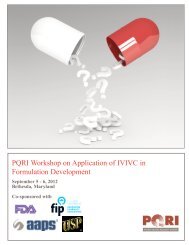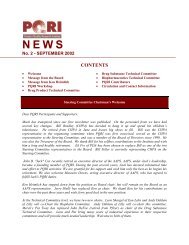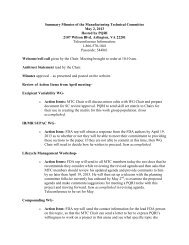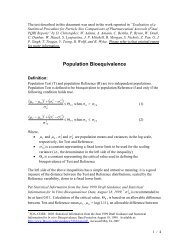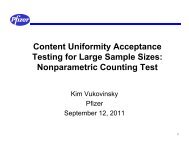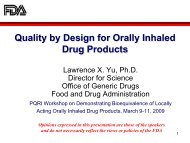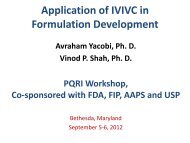Role of Population Approaches in IVIVC - PQRI
Role of Population Approaches in IVIVC - PQRI
Role of Population Approaches in IVIVC - PQRI
Create successful ePaper yourself
Turn your PDF publications into a flip-book with our unique Google optimized e-Paper software.
A Brief Introduction <strong>of</strong><strong>IVIVC</strong> Us<strong>in</strong>g <strong>Population</strong> ApproachJohn Duan, Ph.D.Biopharmaceutics TeamONDQA/CDER/FDAThe f<strong>in</strong>d<strong>in</strong>gs and conclusions <strong>in</strong> this presentation have not been formallydissem<strong>in</strong>ated by the FDA and should not be construed to represent anyAgency determ<strong>in</strong>ation or policy1
Conc (ng/mL)0.0 0.5 1.0 1.5 2.0 2.5 3.0 3.5% Dissolved0 20 40 60 80 100Conc (ng/mL)1 2 3 4 5% Absorbed <strong>in</strong> vivo20 40 60 80% Absorbed0 20 40 60 80 100Traditionally, an <strong>IVIVC</strong> isEstablished by a 2-Stage MethodIn vivo pr<strong>of</strong>ileUIR FunctionAbsorption0 10 20 30 40 50 60Time (h)0 50 100 150 200 250Time (m<strong>in</strong>)Dissolution<strong>IVIVC</strong>0 50 100 150 200 250Time (m<strong>in</strong>)0 50 100 150 200 250Time (m<strong>in</strong>)20 40 60 80% Dissolved <strong>in</strong> vitro2
Alternatively, 1-Stage Method Can Be used• 1-Stage method may overcome the follow<strong>in</strong>g limitations<strong>of</strong> the deconvolution based 2-stage method– Deconvolution is not stable;– Study objectives are <strong>of</strong>ten related to the drug concentrations, notthe fraction <strong>of</strong> drug dissolved.• 1-Stage method may use a population approach– Convolution-based approach– Compartment approach based on differential equations• <strong>Population</strong> <strong>IVIVC</strong> is similar to population PK/PD, seek<strong>in</strong>gthe sources and correlation <strong>of</strong> the variability <strong>in</strong> vivo, <strong>in</strong>vitro and their relationship.• A better understand<strong>in</strong>g <strong>of</strong> population PK will be helpful.3
Conc (ng/mL)Consider<strong>in</strong>g BothInter-Subject and Residue Variability108Inter-subject VariabilityData po<strong>in</strong>ts for ID<strong>Population</strong> fitIndividual fitData po<strong>in</strong>ts for ID 164Residual Variability20 5 10 15Time (h)4
Variability Is Modeled Simultaneouslywith the Parameter EstimatesCLVWT2CL2V2}}Typical valueCovariatePREDyInter-Individual Variability (IIV)Residue variability<strong>Population</strong>predictionCLVWT2CL2V2}Typical value2 2Covariate......}CLiViIIVResidue variabilityObsyiCLCL1VV1......IPRDyIndividualprediction5
<strong>Population</strong> <strong>IVIVC</strong> Uses a Similar ApproachK2KIn Vitro Typical valueIn Vitro VariabilityIn Vitroprediction<strong>IVIVC</strong>2<strong>IVIVC</strong><strong>IVIVC</strong> Estimate<strong>IVIVC</strong> VariabilityCLVWT2CL2}}In VivoTypical valueCovariateIIV <strong>in</strong> vivoPREDyIPRDy<strong>Population</strong>predictionIndividualpredictionV2Vivo Residue variability6
An Example <strong>of</strong><strong>Population</strong> <strong>IVIVC</strong> Structural Model1 2In VitroDosage3 4 5In VivoDosageDissolution<strong>IVIVC</strong> L<strong>in</strong>kDissolutionIn VitroSolutionIn VivoSolutionAbsorptionBloodConc.Elim<strong>in</strong>ation7
Group Discussion• What are the advantages and limitations <strong>of</strong>the population approach?• What is the significance <strong>of</strong> the populationapproach?• What are the possible applications <strong>of</strong> thepopulation approach?8




